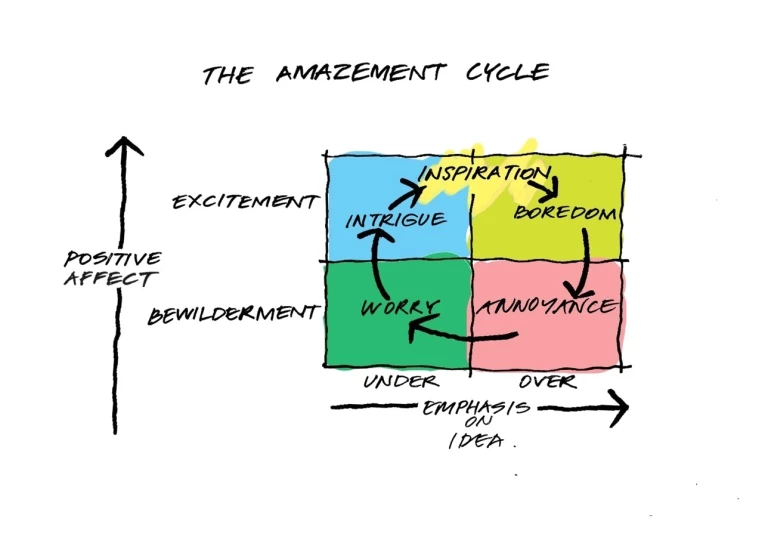B usiness is dominated by plans and analysis. But people are not moved by logic alone. According to the French philosopher Gaston Bachelard, behind every apparently sensible scientist is a child who was irrationally drawn to fire. Reason, when animated by the fire of emotion, has the power to motivate and move individuals more than facts alone ever could. An inspired group is likely to achieve much more than one merely doing its job.
The theme of TED’s 2018 conference,“The Age of Amazement,” reflects the momentous innovation and change going on around us. Taking this cue, we examine the dynamic interplay of logic and emotion that unfolds when we encounter something new, and attempt to extract some hints for how leaders can understand and harness it.
The Amazement Cycle
The word amazement in the 16th century meant bewilderment and only later acquired its positive connotation of inspiration and energization. This ambivalence of meaning is quite natural when we consider the process of encountering novelty. Initially, we may be disturbed or even fearful, but once we have become familiar with the new and can see its possibilities, our initial defensiveness can give way to imagination and energy.
We live in an age of unprecedented change—especially in the domain of technology. It is uncanny that many of the technological possibilities imagined by the creators of the popular science fiction TV series Star Trek have become commonplace realities. For starters, consider big screens, cell phones, replicators, and personal translators. Yet the emotions we associate with such novelty can run the gamut from excitement to tedium. At first, we might be bewildered and worried by new technology, then curious, then inspired at the thought of the possibilities unlocked for us, but later we can become bored or even irritated by the over-emphasis on now familiar themes. All too often, we end up bewildered by the seemingly endless stream of new phone models, startups with a never-ending array of quirky new offerings, or news articles trumpeting the latest technological revolution.
The emotions we associate with novelty can run the gamut from excitement to tedium.
Let us then take a journey through the dynamics of amazement to see if we can discern the underlying pattern, in order to better harness the power of ideas and emotions.
Worry
We begin our journey with encountering the unknown: the moment we intuit that some unfamiliar idea may be in the air. We sense difference, and perhaps a challenge to our current beliefs or behaviors, but we have not yet understood, let alone internalized, the idea. Our reaction is one of caution and defense, or even outright denial. As German embryologist Karl Ernst von Baer noted, all truth goes through three stages: first people say it is untrue, then that it is against religion, then, finally, that we knew it all along.
These emotions of resistance and denial make sense in the context of the history of our species. When our ancestors encountered something novel, like a sound in the bushes, it was best to err on the side of caution and take flight. Yet this is not our only option. One theory about the origin of general intelligence is that it began as an adaptation to cope with novelty. We can evolve standard mechanisms to recognize faces or run away from lions, but if lightning sets fire to our campsite, then we need to think on our feet. The fire might be bewildering, but instead of fleeing, we can take worry as a cue to engage productively with the unknown.
Instead of fleeing from the unknown, we can take worry as a cue to engage productively with it.
Likewise, in business, we are often worried by maverick disruptors threatening incumbent firms from the margins of our industry. We know statistically that most unproven business models will fail. Yet we also know that what seems implausible may in fact be very powerful and merely unfamiliar to us. The intelligent approach at this stage is to employ contingent thinking. Instead of asking, is this a good idea, we can ask ourselves: if this were a good idea, what would be the consequences and what could our options be? In other words, rather than being dismissive, we can worry productively.
Intrigue
Just as one of our ancestors, at some point, looked with curiosity instead of fear at fire, our worry can give way to intrigue. If we have employed contingent thinking, we may have reached this point early enough to be looking at an opportunity rather than an imminent threat.
To nurture our intrigue, we must indulge in play and experimentation. Play is essentially a “toy” version of the world. What we say or do in playful situations is not linked directly to real-world consequences or limited by practical constraints. Sir Tim Berners-Lee described the process of inventing the World Wide Web as “a step of generalizing, going to a higher level of abstraction, thinking about all the documentation systems out there as being possibly part of a larger imaginary documentation system.” Initially, he was simply intrigued and excited by his “imaginary documentation system.”
In the early stages of developing a new idea or business, we are effectively competing on imagination.
We can’t calculate the net present value of or mechanically manage such creative steps. Instead, we should recognize that in the early stages of developing a new idea or business we are effectively competing on imagination, and we need to lower barriers to curiosity and tinkering in order to reveal hidden possibilities.
Inspiration
Amazement and innovation are inherently social phenomena. Intrigue can naturally give way to inspiration, which makes us feel not merely curious but also energized by the possibilities that we begin to see. We begin to own the idea and feel moved to share our excitement with others. We have made a transition from object to subject, from observer to actor and champion.
As champion of an idea, we want to lead others through journeys of amazement, past worry through intrigue to inspiration. The story of how yogurt became popular in the US provides a powerful example. In the early 20th century, yogurt was largely unknown in the US and Western Europe, except perhaps as an obscure health food from the Balkans. Then Daniel Carasso bought a small Greek yogurt kitchen in the Bronx in 1941 and renamed it Dannon. Bit by bit, along with other companies, Dannon shifted peoples’ idea of yogurt from “weird” to “exciting.” From such unpromising origins, it is now a billion-dollar business and part of many people’s daily routine.
Boredom
Whether we are seduced by a novel idea or not, it’s likely that its original champions will continue to emphasize their gospel. But at this point, we may have started to become bored with the repetitive message. There may be an objective need to embrace the idea, and we may recognize this intellectually, but emotionally we have begun to resist the message. We resist becoming the object of someone else’s promotion scheme. This protective impulse may of course delay our adoption of the idea, perhaps to our own detriment. However, it can also protect us from becoming the last punter to buy yesterday’s idea, while pioneers have moved on to fresher pastures.
Boredom can play a useful role. We should consider it as a legitimate part of the process of amazement, because we often must pass through this state to be receptive to new inspirations. We can’t remain at a high pitch of excitement permanently. Once we have witnessed the birth of a new thing (perhaps a yogurt business, or the World Wide Web), it is natural that we become a little bored. As psychotherapist Adam Phillips notes, the ability to feel boredom is actually a developmental achievement for a child—it is the valuable ability to endure waiting for something without knowing what that thing could be. In a culture full of images of inspiration and purposefulness, it’s helpful to acknowledge the importance of the feeling that comes after amazement and inspiration end, and to appreciate this emotion as the substrate for new journeys of amazement.
We often must pass through boredom to be receptive to new inspirations. We can’t remain at a high pitch of excitement permanently.
Annoyance
As the market for an idea unfolds, its original champions have an incentive to push for the full penetration and exploitation of their idea. While early adopters may have been self-motivated, laggards likely require more pushing and may be pressured to contemplate the negative consequences that may unfold if they do not adopt the idea. At this point, the repetitive emphasis becomes positively annoying, and many will be inclined to close their ears and move on to the next source of intrigue.
Harnessing the Cycle of Amazement
It’s no wonder that the origins of the word amazement involve emotional ambivalence. During the different stages of encountering novelty, we experience a range of emotions: we might be amazed and worried, amazed and intrigued, or amazed and inspired. By understanding these dynamics, idea champions and adopters alike can develop a greater awareness of the interplay of ideas, emotions, and timing that lies at the core of innovation—and use this understanding productively to shape idea-journeys for themselves and for those around them.
The BCG Henderson Institute is Boston Consulting Group’s strategy think tank, dedicated to exploring and developing valuable new insights from business, technology, and science by embracing the powerful technology of ideas. The Institute engages leaders in provocative discussion and experimentation to expand the boundaries of business theory and practice and to translate innovative ideas from within and beyond business. For more ideas and inspiration from the Institute, please visit Featured Insights .
The Business Romantic Society helps leaders and organizations identify and articulate their visions and translate them into transformation stories, emotional experiences, and human-centered growth strategies.
The House of Beautiful Business
is a pop-up community focused on creating positive visions for technology and humanity; to be next hosted at the Web Summit in Lisbon from November 3–8, 2018.











